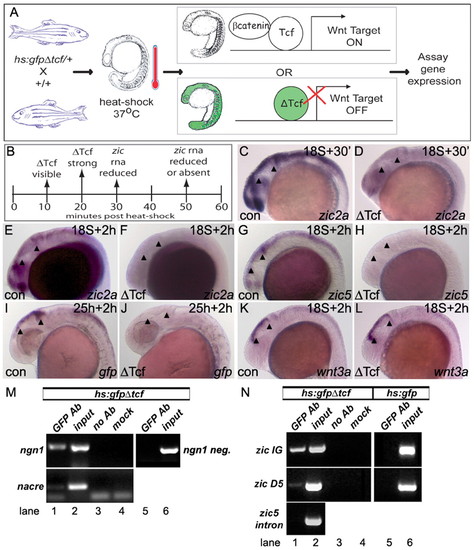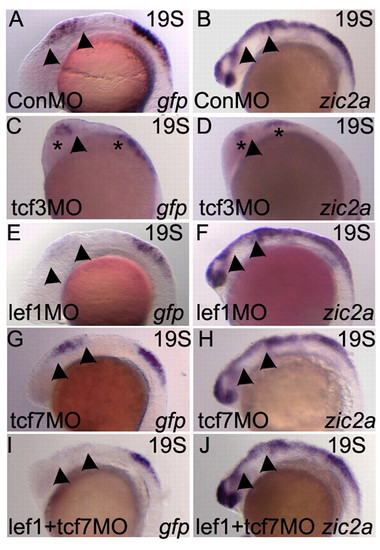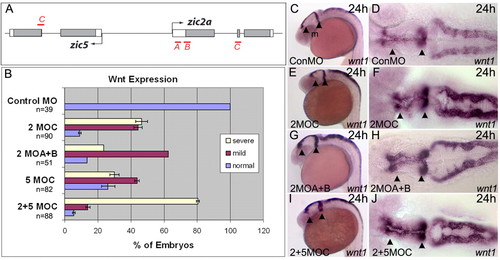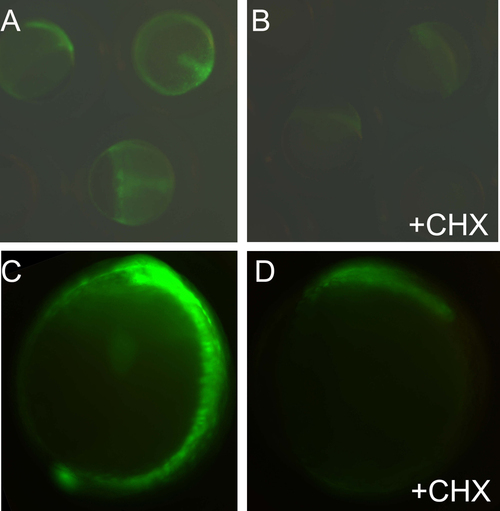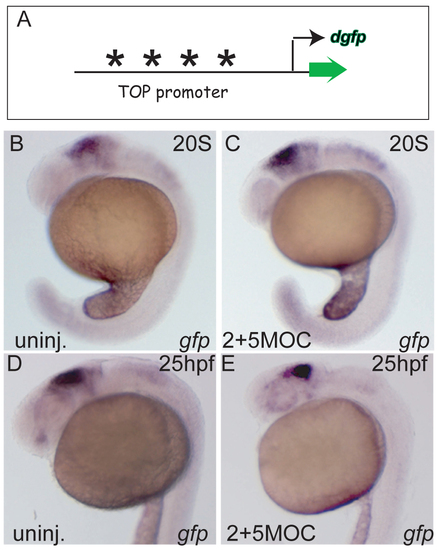- Title
-
The zebrafish zic2a-zic5 gene pair acts downstream of canonical Wnt signaling to control cell proliferation in the developing tectum
- Authors
- Nyholm, M.K., Wu, S.F., Dorsky, R.I., and Grinblat, Y.
- Source
- Full text @ Development
|
Zic2a and zic5 are linked and co-expressed in presumptive dorsal brain. (A) Genomic arrangement of zic2a and zic5. Coding regions are shown as gray boxes, non-coding transcribed regions as white boxes, and introns as lines. (B-G) Embryos stained by ISH for zic2a or zic5 (purple), and dlx3 (orange). (B) At midgastrula stages, zic2a is expressed throughout neurectoderm, whereas dlx3 marks the adjacent non-neural ectoderm. (C) By late gastrula stages, zic2a is restricted to the lateral neural plate and forms a sharp border with dlx3. (D,E) During somitogenesis, zic2a and zic5 are similarly expressed in the dorsal neural tube, ventral diencephalon and optic stalks. (F,G) At 24 hpf, zic2a and zic5 are coexpressed in the optic stalk, telencephalon and dorsal diencephalon, and weakly in the tectum. All views are lateral, anterior to the left, except in B,C where anterior (a) is at the top. Arrowheads mark anterior and posterior borders of presumptive midbrain. d, dorsal; m, midbrain; h, hindbrain; os, optic stalk; tel, telencephalon. |
|
Transient transgenic analysis of zic2a-zic5 genomic regions. (A) Conserved DNA regions (thick lines) at the zic2a-zic5 locus. P2 and P5, each approximately 300 nt, are 70% identical with Fugu. IG (840 nt) is 49% identical to Fugu, and D5 (535 nt) is 60% identical to Fugu. Eight consensus Tcf/Lef-binding sites were found in IG and six in D5 (asterisks). (B) Transgenic constructs tested in transient assays. (C,D) Dorsal midbrain and hindbrain expression of Gfp in representative zic5D5:gfp and zic2aD5:gfp transient transgenics. Insets are dorsal views of the embryos shown. Asterisks mark mid-hindbrain organizer. (E-G) gfp RNA in representative transient transgenics. In embryos injected with 25 pg of zic2aD5:gfp (E) or zic2aD5ΔIG:gfp (F), expression was concentrated in dorsal midbrain and hindbrain. Embryos injected with 25, 50 or 70pg of zic2a:gfp (G) did not show enhanced expression. All views are lateral, except for insets. |
|
Transient transgenic analysis of zic2a-zic5 genomic regions. (A) Conserved DNA regions (thick lines) at the zic2a-zic5 locus. P2 and P5, each approximately 300 nt, are 70% identical with Fugu. IG (840 nt) is 49% identical to Fugu, and D5 (535 nt) is 60% identical to Fugu. Eight consensus Tcf/Lef-binding sites were found in IG and six in D5 (asterisks). (B) Transgenic constructs tested in transient assays. (C,D) Dorsal midbrain and hindbrain expression of Gfp in representative zic5D5:gfp and zic2aD5:gfp transient transgenics. Insets are dorsal views of the embryos shown. Asterisks mark mid-hindbrain organizer. (E-G) gfp RNA in representative transient transgenics. In embryos injected with 25 pg of zic2aD5:gfp (E) or zic2aD5ΔIG:gfp (F), expression was concentrated in dorsal midbrain and hindbrain. Embryos injected with 25, 50 or 70pg of zic2a:gfp (G) did not show enhanced expression. All views are lateral, except for insets. EXPRESSION / LABELING:
|
|
Tcf/Lefs are required for zic gene expression. (A) The method used to disrupt Tcf/Lef signaling at controlled times. (B) Temporal correlation between GfpΔTcf induction (by fluorescence) and zic2a RNA (by ISH). (C-L) Representative embryos after ISH. Stage of heat-shock and recovery time are indicated at upper right. Zic2a expression is normal in ΔTcf-negative heat-shocked controls (C,E), and reduced or absent in ΔTcf-positive siblings (D,F). Zic5 expression was normal in ΔTcf-negative (G) embryos, and absent in ΔTcf-positive embryos (H). Zic2aD5:gfp expression was normal in ΔTcf-negative embryos (I) and absent in ΔTcf-positive embryos (J). Wnt3a expression was normal in heat-shocked controls (K) and in ΔTcf-positive siblings (L). All views are lateral, anterior to the left. Arrowheads mark anterior and posterior tectal borders. (M,N) Gfp ChIP analysis of heat-shocked Tg(hs:gfpΔtcf) and Tg(hs:gfp) embryos. Genotype of embryos and PCR templates are shown above, as follows: GFP Ab, chromatin after anti-Gfp IP; input, total chromatin before IP; no Ab, no-antibody ChIP; mock, no chromatin. Regions amplified are labeled next to the corresponding bands. (M) Promoters of known Wnt targets, ngn1 and nacre. An upstream region of ngn1, lacking functional Tcf/Lef-binding sites (lane 5). (N) IG and D5 regions of zic2a-zic5 and zic5 intron. EXPRESSION / LABELING:
|
|
Ectopic activation of the canonical Wnt pathway induces zic gene transcription. (A-C) Embryos were injected with hs:ßCat-gfp DNA, heat shocked at shield-stage, and assayed for zic2a (purple) and gfp (orange) at late-gastrula. (A) ßCat-gfp is expressed in the medial neural plate; the zic2a pattern is normal (no ectopic expression; n=10, two experiments). (B,C) ßCat-gfp is expressed in lateral ectoderm; zic2a is ectopically expressed (arrows; n=8, 8 ectopic, two experiments). (D) Control embryo expressing hs:gfp in lateral ectoderm showing no ectopic zic2a expression (n=18, 0 ectopic, one experiment). a, anterior. (E-G) Zic2aD5:gfp embryos injected with GR-Lef RNA and assayed for gfp RNA at late-gastrula (purple). (E) GR-Lef-injected embryo showing weak ectopic gfp (arrow). (F,G) GR-Lef-injected embryos treated with DEX (F) or DEX and CHX (G). (H) Uninjected zic2aD5:gfp control treated with DEX. (I) Summary of GR-Lef overexpression experiments, showing the proportion of embryos expressing gfp for each treatment condition. The number of embryos scored for each condition is listed along the x-axis. |
|
Multiple Tcf/Lefs are required for zic gene expression. Embryos injected with the MOs shown at the lower left of each panel and stained for zic2aD5:gfp (A,C,E,G,I) or zic2a (B,D,F,H,J) at 18 hpf. (C-D) Strongly affected tcf3 morphants had anterior trunctions and reduced zic2aD5:gfp (asterisks) and zic2a domains. (E-J) lef1 morphants showed a strong reduction in zic2aD5:gfp (E) and a mild reduction in zic2a (F). tcf7 morphants showed a mild reduction in zic2aD5:gfp (G), but normal zic2a (H). lef1+tcf7 morphants showed a strong reduction in zic2aD5:gfp (I) and mild reduction in zic2a (J). All views are lateral, anterior to the left. Arrowheads indicate the midbrain. EXPRESSION / LABELING:
PHENOTYPE:
|
|
MO knockdown of zic2a and zic5 disrupts dorsal midbrain formation. (A) MO-binding sites in the zic2a-zic5 locus. Coding regions are shown as gray boxes, non-coding transcribed regions as white boxes, and introns as lines. MO-binding sites are designated with red lines. (B-J) Embryos injected with indicated MOs were assayed for expression of wnt1 or wnt3a at 24-25 hpf. Error bars in B show s.e.m. (C,D) Embryo injected with conMO (8 ng) showing normal wnt1 expression. (E,F) Severely affected embryo injected with 2MOC (2 ng) showing disorganized wnt1 expression in dorsal midbrain and hindbrain. (G,H) Mildly affected embryo injected with 2MOA+2MOB (6.6 ng). (I,J) Embryos co-injected with 2MOC and 5MOC (1 ng each) showing severe defects in wnt1 expression. C,E,G,I are lateral views; D,F,H,J are dorsal views of the embryos shown to the left; embryos are positioned with anterior to the left. Arrowheads indicate the midbrain. |
|
Knockdown of zic2a and zic5 disrupts midbrain morphology, but not DV pattern. Embryos were injected with conMO (8 ng), or 2MOC and 5MOC combined (1 ng each), and stained for DV marker expression by ISH. (A-D) Marker expression in 19-somite embryos. wnt3a marks dorsal midline and adjacent cells in midbrains of conMO-injected embryos (A) and in zic morphants (B). pax7 marks alar midbrain in controls (C) and morphants (D). (E-T) Marker expression in 24-hpf embryos. wnt3a is expressed in dorsal tectum of conMO-injected embryos (E-G). (H-J) wnt3a domain in zic morphants. (K-M) pax7 in the alar tectum of controls. (N-P) pax7 in zic morphants is reduced, but correctly positioned. (Q,R) hlx1 marks basal plate midbrain of controls (Q) and zic morphants (R). (S,T) shh in ventral midbrain of controls and zic morphants. A-D,E,H,K,N,Q-T are lateral views, anterior to the left; F,I,L,O are dorsal views of embryos at left; G,J,M,P are midbrain cross-sections at positions indicated by lines in images to left. Arrowheads indicate the midbrain. EXPRESSION / LABELING:
PHENOTYPE:
|
|
Cell proliferation is reduced in the dorsal midbrain of zic morphants. (A) A comparison of average mitotic index in control (blue) and 2MOC+5MOC (pink) morphant midbrains. Mitotic index (y-axis) was calculated at nine DV positions (x-axis) at the 19-somite stage. Error bars show s.e.m. Asterisks mark statistically significant reductions in mitotic index. (B-D) PH3 (green) staining in representative confocal z-sections through midbrain dorsal position 3 in control (B) and zic MO-injected (C,D) embryos. (E-G) A merge of PH3 and nuclear ToPro3 (red) staining in embryos shown above. (H-M) Confocal z-stacks of 19-somite conMO (H-J) and 2MOC+5MOC-injected (K-M) embryos immunostained for Pax7 (red) and PH3 (green). H,K are stacks of dorsal-most Pax7 domain; I,L are stacks of ventral Pax7 domain; J,M are stacks of ventral midbrain. EXPRESSION / LABELING:
PHENOTYPE:
|
|
Comparison of TOP:GFP and zic2aD5:gfp expression. Embryos were processed by ISH to detect gfp RNA. (A) Transgenics carrying the Wnt-responsive transgene TOP:GFP (Dorsky et al., 2002) show strong midbrain and weak hindbrain expression at 10 somites. (B) zic2aD5:gfp is weakly expressed in the midbrain and strongly expressed in the hindbrain at the same stage. (C,D) At a later stage (20 somites) TOP:GFP expression overlaps with zic2aD5:gfp, primarily in the midbrain. All views are lateral, anterior to the left. Arrowheads mark the tectal borders. |
|
Cycloheximide inhibits translation. Transgenic flh:gfp (Gamse et al., 2003) embryos were treated with vehicle (DMSO) (A,C) or CHX (B,D) and scored for expression of Gfp by fluorescence. (A,B) Embryos treated at sphere stage and scored at 80% epiboly. Vehicle-treated control embryos (A) show normal levels of Gfp, while expression is barely detectable in embryos treated with CHX (B). (C,D) Embryos treated at 50% epiboly and scored at 100% epiboly. Gfp expression was much reduced in CHX-treated embryos compared to vehicle-treated controls. Note that transgenic Gfp expression had already begun by the start of the earliest CHX treatment at sphere stage. Gfp protein is very stable, making it likely that some of the remaining Gfp fluorescence is due to pretreatment synthesis. |
|
Tcf3 reduction affects midbrain size. (A-C) Uninjected control embryos showing normal zic2aD5:gfp (A), zic2a (B) and wnt3a (C) expression at 18-somites. (D-O) Embryos injected with tcf3 MOs and assayed for zic2aD5:gfp (G,J,M), zic2a (H,K,N), or wnt3a (I,L,O) expression at 18-somites. Knockdown of Tcf3 resulted in expanded expression of all markers in the midbrain at low MO concentrations. This is most likely due to the previously documented overall midbrain expansion (D-I). At higher MO concentrations, zic2aD5:gfp and zic2a were reduced in midbrain (J,M,K,N), whereas wnt3a expression remained strong (L,O). Embryos are shown in lateral view, anterior to the left. Arrowheads mark anterior and posterior limits of the midbrain. EXPRESSION / LABELING:
PHENOTYPE:
|
|
TOP:GFP expression in zic morphants. As zic1 was recently shown to regulate wnt genes (Merzdorf and Sive, 2006), we asked if Wnt signaling was affected in zic2a-zic5 morphants by assaying expression of a Wnt reporter transgene. This analysis, although not quantitative, suggested that Wnt signaling was not altered in zic morphants. (A) TOP:GFP transgene contains a wnt/β-catenin responsive synthetic promoter (TOP) composed of four consensus Lef-binding sites (blue stars) and a minimal promoter sequence, driving a destablized gfp reporter (Dorsky et al., 2002b). TOP:GFP transgenic embryos were injected with 2 MOC+5MOC (C,E), and gfp expression was compared with uninjected embryos (B,D) at 20-somites or at 25 hpf. (B,C) At 20-somites, TOP:GFP expression in morphants (n=24) was comparable to that in uninjected embryos (n=18). (D,E) At 25 hpf, the TOP:GFP expression domain was misshapen in morphants (n=20/82), probably as a result of morphological defects, as compared with controls (n=18). However, there was no significant expansion or reduction in TOP:GFP expression. All embryos are positioned in lateral view, with anterior to the left. |

Unillustrated author statements PHENOTYPE:
|




